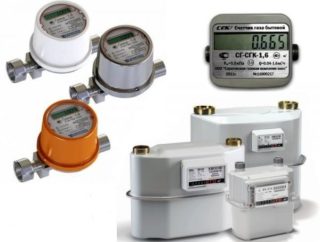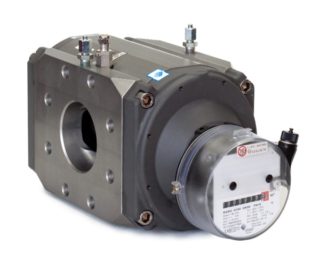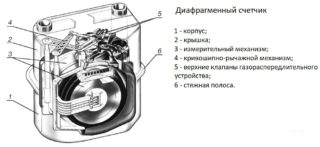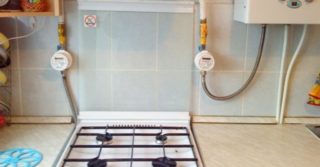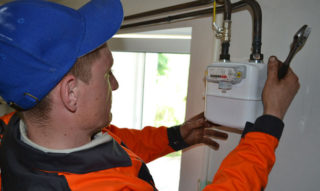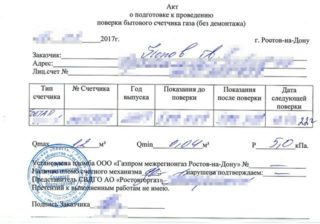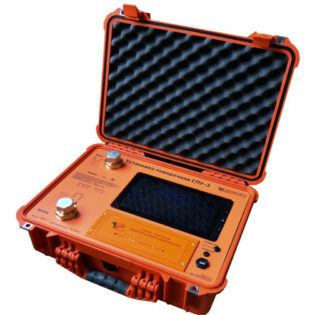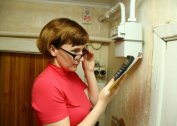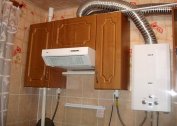Calibration of a gas meter is a procedure for assessing the ability of a device to correctly reflect the consumed fuel volume. It is supposed to be carried out with a certain periodicity in all organizations, apartments and private dwellings in which metering devices are installed.
Variety of gas meters
The flow meter is built into the gas line supplying the resource to the room. Devices vary in design. The method of operation can be based on taking into account the characteristics of the movement of the mechanism initiated by the properties of the fuel, or on the analysis of pulses generated by the sensors during the passage of gas. Indications are displayed to the consumer through a counting unit or electronic display.
Whirlwind
The operation of devices of this type is based on the analysis of the frequency of pressure changes that appear when the path of a gas passing through a meter has the form of a vortex. As a rule, such devices are mounted in industrial or municipal premises. For home use, other types of meters are available. Vortex models have complex electronic components inside and belong to expensive devices.
Turbine
Here, the gas stream initiates torsion of a turbine element provided with bearings. The main accounting parameter is its speed. Since the bearings dry out when the gas flows through the mechanism, for the smooth functioning of the device they need to be regularly lubricated. This function is performed by a pump mounted in the device. Like the previous type of apparatus, turbine models are industrial devices. Their large sizes and excellent throughput predispose to this. Newer models are usually equipped with sensors that record pressure and temperature readings.
Most often, such gas meters have a cylinder-shaped housing. At the entrance, they have a rectifier assembly. Behind it is the main component - a rotating turbine. The number of revolutions depends on how much gas fuel has passed through the structure. The counting unit of the device can be either mechanical or electronic.
The advantages of turbine devices are ease of maintenance, independence from electricity, and a long service life. They work almost silently. Such meters are not very demanding on gas purification. The downside is the generation of significant errors during intermittent operation. It is better to purchase such a meter for operation in the trunk with a constant supply of a resource.
Rotational
Devices with rotor blades are designed for installation on a vertical pipe, along which the gas moves downward. The movable unit consists of two 8-shaped blades adjacent to each other, rotating in opposite directions. They are tightly fixed in a special box. This prevents excessive gas losses (provided that the pressure does not go beyond the specified limits).
The receipt of the resource initiates the torsion of the blades. This is achieved due to the pressure difference between the supply and output. A single revolution redirects a clearly defined amount of gas. The fixation of the number of torsions and their translation into units of volume is performed by a counting mechanical unit. Resource losses are also recorded. This provides a high accuracy counter.
The device has many advantages - non-volatility, small dimensions, almost silent operation, good bandwidth. It is capable of measuring over a wide range. The downside is the short time between inspections - 5 years. This is due to the design with a movable blade unit.
Membrane
Instruments of this type are popular due to their high accuracy combined with ease of use. They are used for apartments and houses located in the private sector. In the case of the device, boxes with membrane elements are installed, communicating with each other by means of tubules. The latter are equipped with valves, the opening and closing of which is due to the transfer of force through a special unit with levers.
When gas is supplied inside, the first box is filled first. After that, the valve opens, redirecting fuel to the second chamber. And so it passes sequentially through all the boxes with membranes located inside the case. The more of them, the more accurate the data will be received.
Such metering devices have a significant interval between verification (10 years or more) and operation in general (up to 20 years). They function normally on a resource of low purification. The disadvantages include the generation of wheezing noise (the severity depends on the activity of gas consumption), as well as oversize. The latter is not a problem for a private household, but can be annoying when installing a meter in a small apartment.
Frequency of use of a gas meter
Passport is always included in the gas meter package. This document indicates the technical specifications of the device. From the passport you can find out after how many years of operation you need to check. In addition, it indicates the total life of the device. After this time, the counter is dismantled, followed by the installation of a new apparatus.
In a private house
Installation of a device for servicing a private house can be carried out in one of the utility rooms and on the street or on a plot of land adjacent to the construction. The service life is affected by how many devices (column, stove, etc.) are connected to the meter. The more of them, the shorter the likely duration of operation.
In the apartment
With a small number of residents and a resource consumption of less than 2 cubic meters per hour, gas meters are not accepted to be installed. In this case, residents pay gas in accordance with applicable regulations.
If the device is functioning properly and shows good results on verification, the replacement is carried out after the expiration of the period of operation specified in the passport. For different models, it can be from 8 to 20 years. But there are situations when a premature replacement of the gas meter is required:
- lack of indication of digital indicators on the display;
- flown seal;
- unsatisfactory verification results;
- damage that violates the correct functioning.
Such problems are usually caused by improper installation of the device or operating conditions (humid air, lack of dust filter).
Low transmittance models are particularly prone to premature failure.
Purpose and procedure for verification
Verification of gas meters is made to assess the health of the device and the accuracy of its measurements. Since the equipment is subject to wear and deformation of spare parts during operation, the relevance of the readings may decrease over time. In this case, the meter can show values that are inferior to the real volume of consumption, and exceed it.To be sure that the resource is paid adequately for its actual use, after several years of operation (their number is indicated in the passport), the device must be checked.
It is possible to carry out the verification procedure of a gas meter without removal. In this case, the service worker arrives at the owner’s house. You can take the removed device to the laboratory yourself. The price of the first option is slightly higher.
If the inspection is planned, the consumer must be notified in advance of the arrival of a specialist. The arrived master must check for directions. If the owner of the home has found a malfunction of the device, an unscheduled test should be organized.
Terms of verification of counters
You can find out the verification intervals for your counter by opening the data sheet. The value ranges from 4 to 12 years. The total duration of operation of the device is considered not from the date of its installation, but from the day of manufacture.
What documents are needed for verification
As a rule, the need for verification is mentioned in the instrument maintenance contract. It is assumed that the tenant after a certain period calls the representative of the company to dismantle the gas meter and deliver it to the diagnostic laboratory. In addition, you can apply for verification measures to the gas service. You need to bring other documents with him - the passport of the owner and the device.
Upon successful acceptance of the application, the service employees leave for the consumer on a predetermined day. They disassemble the device, install an arcuate tube and prepare a verification document. After that, the consumer takes the gas meter to the laboratory. If, according to the test data, the device is recognized as serviceable and suitable for further use, an appropriate mark is made in the passport. If it turned out to be out of order, a gas consumer is issued a document prohibiting the further operation of the device.
The removal of the device, the testing process itself, the installation of the meter are carried out anew at the expense of the gas consumer. The same applies to repair measures (if necessary). Only primary filling is free of charge.
Gas metering during meter reading
While the device is being tested, resource consumption is calculated according to average monthly rates. This rule applies if tenants have used the meter for at least a year. Upon completion of verification procedures, you need to apply for sealing. It must be performed by representatives of the gas service within a week from the date of consideration.
Possible fines
For a homeowner who has not had time to believe the gas meter on time or who has ignored the procedure, a requirement is set to pay for the resource according to general standards. If a person refused to let a gas service representative in charge of checking, an administrative fine of up to 2 thousand rubles may be imposed on him. This sanction does not invalidate the need to check the meter (if the consumer prefers to pay according to real indications, rather than according to general norms).
Checking the gas meter without removing
It is possible to verify gas meters at home without removing the apparatus. When calling the representative of the gas service, you need to indicate the desire to test the meter using a portable installation.
Verification without removal is performed in the following order:
- the service worker arrives at the consumer’s house and goes to the installation site of the device;
- the homeowner removes foreign objects from the gas stove (if other equipment also works from the gas, you need to free up space in accordance with the instructions of the inspector);
- the master inspects the apparatus, checks the integrity of the seal;
- if there is no damage, a mobile installation is connected to the device, the necessary calibration procedures are performed;
- the installation is turned off, the connecting sections are mounted, and there is no leakage.
The employee enters the necessary entries in the certificate of verification and in the journal. The consumer is issued a receipt for the services that he pays. The homeowner retains the certificate until the next verification.
Checker
For testing home and utility gas meters, special portable cases are available. The wide profile of the plants allows operation with meters of various designs and with a wide range of hourly gas flow rates. Using the device, the device is checked in place without disconnecting from the gas pipeline.
Mobile devices can operate from an independent power source for 10 hours or more. The verification algorithm is used general, approved by state standards, or developed for a certain type of meters. According to the standards, it is advisable to do the procedure in the environment with which the device works, only if there is no possibility of testing for gas, it is allowed to use air.
